- News
- Reviews
- Bikes
- Components
- Bar tape & grips
- Bottom brackets
- Brake & gear cables
- Brake & STI levers
- Brake pads & spares
- Brakes
- Cassettes & freewheels
- Chains
- Chainsets & chainrings
- Derailleurs - front
- Derailleurs - rear
- Forks
- Gear levers & shifters
- Groupsets
- Handlebars & extensions
- Headsets
- Hubs
- Inner tubes
- Pedals
- Quick releases & skewers
- Saddles
- Seatposts
- Stems
- Wheels
- Tyres
- Tubeless valves
- Accessories
- Accessories - misc
- Computer mounts
- Bags
- Bar ends
- Bike bags & cases
- Bottle cages
- Bottles
- Cameras
- Car racks
- Child seats
- Computers
- Glasses
- GPS units
- Helmets
- Lights - front
- Lights - rear
- Lights - sets
- Locks
- Mirrors
- Mudguards
- Racks
- Pumps & CO2 inflators
- Puncture kits
- Reflectives
- Smart watches
- Stands and racks
- Trailers
- Clothing
- Health, fitness and nutrition
- Tools and workshop
- Miscellaneous
- Buyers Guides
- Features
- Forum
- Recommends
- Podcast
feature
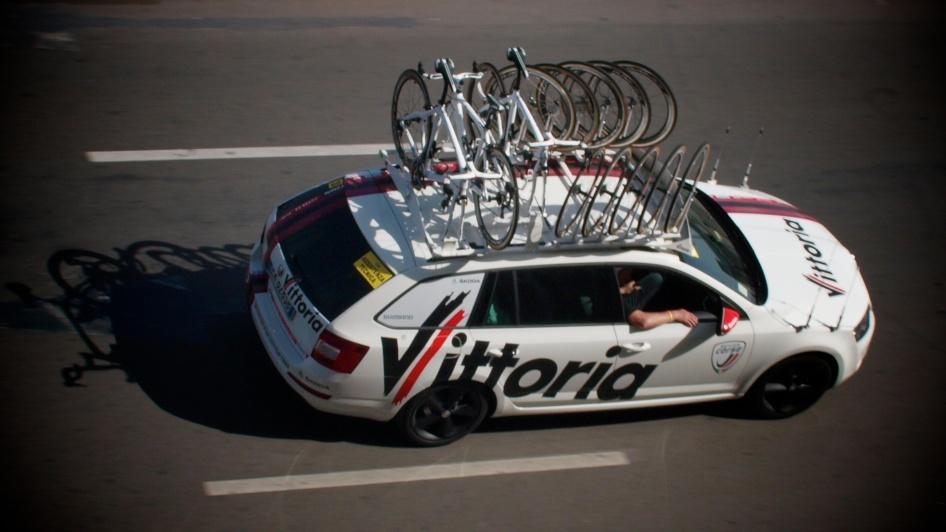 Vittoria Servizio Corse Giro 2013 001 © Simon MacMichael
Vittoria Servizio Corse Giro 2013 001 © Simon MacMichaelInside the Giro d'Italia with Vittoria Servizio Corse - the peloton's Guardian Angels
Besides producing tyres - the company celebrates its 60th anniversary this year - Vittoria is also neutral service provider for races such as all the events organised by RCS Sport, including the Giro d'Italia, earning the nickname "the Guardian Angels of the peloton." So when an invitation arrives asking if we'd like a seat in a car for a stage of this year's race, naturally we jump at it - it's an unmissable chance to see the Giro from the inside.
In Sorrento for the start of Stage 3, a 222km run along the coast down to Marina di Ascea, I find the Vittoria bus and am introduced to the two men with whom I'll be spending the day; Albino Marton, and Francesco Villa, both experienced drivers and mechanics, and decent amateur racers in their day.
Albino has worked in neutral service for more than two decades with Campagnolo, then Shimano and finally Mavic before arriving at Vittoria; Francesco, meanwhile, spent 20 years as a team mechanic or bus driver for Gatorade, Polti, Mapei, Quickstep and BMC. They know their way around bikes, and they know their way around Italy.
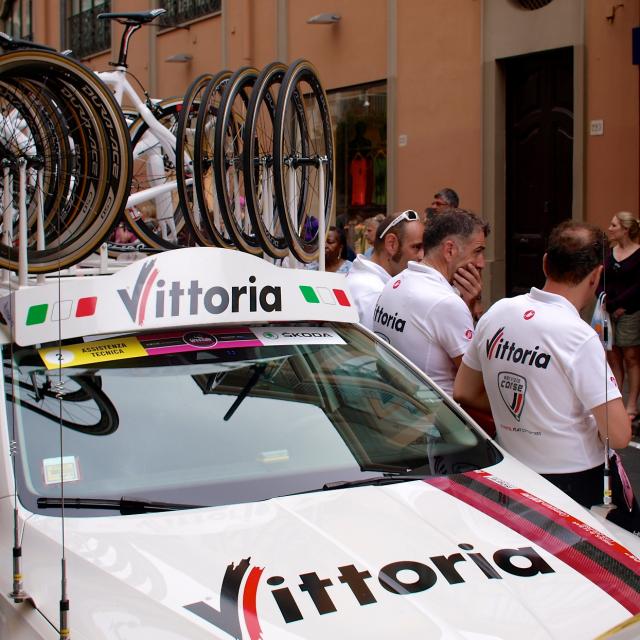
While it's a full-time, day-in, day-out role for the 3 weeks of the Giro, like Vittoria's other neutral service staff, both now have lives away from racing; Albino owns a sports memorabilia shop that also sponsors the under-23 team he manages, while Francesco owns a cafe.
Other staff include ex-pros - there are three former world champions at various levels and disciplines on the team. Everyone has huge amounts of experience, and of course are passionate about bike racing.
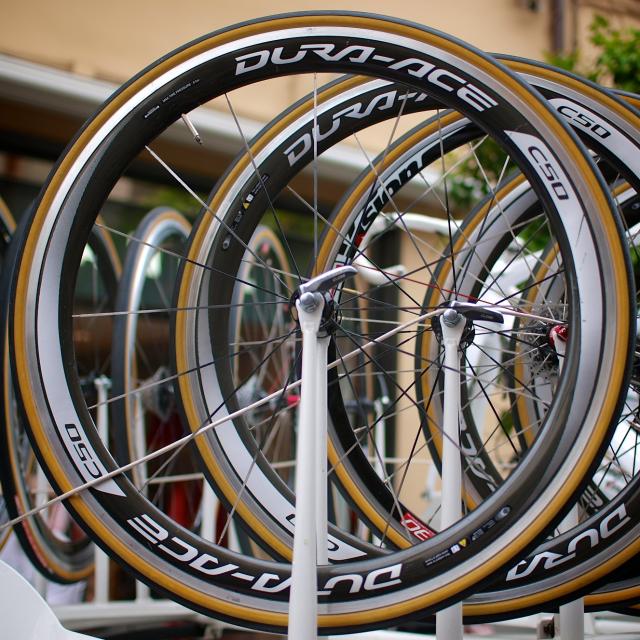
Waiting by the three Vittoria cars on Sorrento's Corso Italia while the riders sign on ahead of the start, I get a chance to ask some of those questions that have often occurred to me - I'll freely admit I'm not the most technically minded person - when watching races.
One of those doesn't even need to be asked as a pair of the Vittoria staff run through which teams are using which groupsets today, Campagnolo or Shimano/SRAM - easy enough to find out - but more importantly, 10 or 11 speed.
Having checked the latter point with teams in the morning, stickers with team jerseys are put on a sheet of paper that shows who's using what, one of those going in each car.
Stickers also go on the rims of the wheels that sit to the left of the mechanic in the rear seat - Vision for those using Campagnolo, Shimano for those on that brand or SRAM - so that the appropriate one can be immediately grabbed should a rider require a change and the team car isn't around.

Each car also has three bikes on the roof - Pinarello Dogma, with an elegant white paintjob, finished with FSA components including matching white integrated bars and stems. There are three sizes, as well as a variety of pedals, and each looks pristine, as they should - they're only used in extremis, and then only until a team car arrives.
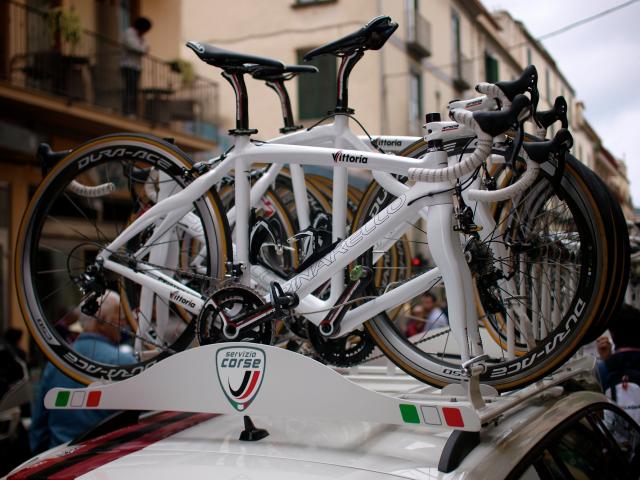
In fact, it's eye-opening how few technical interventions the Vittoria team has to make on a race as long and demanding as the Giro - between 13 and 15 wheel changes in a typical year, although the 'strade bianche' stage of 2011 to Orvieto saw them carry out 5 in just one day.
Other technical help, relayed by RCS over race radio, may include responding when a rider has shipped their chain, or making repairs and adjustments from the car while it is in motion, as well as other duties such as providing water - the bottle always opened immediately before it is given to the rider - or taking bidons or clothing once they are no longer needed.

While the interventions may be rare, they must be executed perfectly; as in Formula 1, ones that go wrong can linger long in the memory, such as when Cadel Evans, challenging for the Vuelta in 2009, lost vital time to eventual winner Alejandro Valverde following a disastrous wheel change. Vittoria wasn't the neutral service provider on that race.
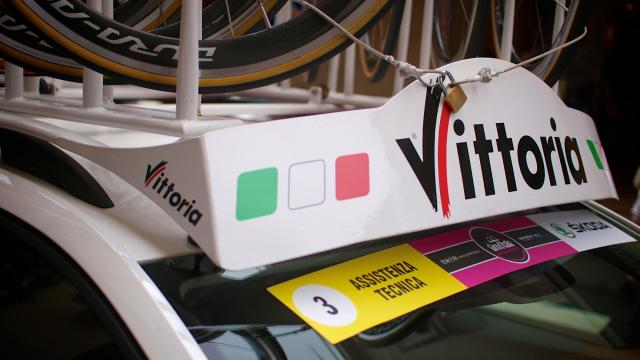
Suddenly, we get the word over race radio to go. We leap into the car, and slot in behind the race director's vehicle; of the three Vittoria cars, we're designated the first, and our job will be to follow the day's break. One of the others will preceded the main group, the third following it.

The stage opens with two laps of a circuit in Sorrento, and immediately from kilometre zero, the break forms that will spend most of the day out in front. Once we get the word over race radio that it is sufficiently clear of the peloton, we pull over and let the riders pass, pulling back out to follow them.
As their team cars make their way up, we fall back to take up last position. Francesco has already performed a visual check on the riders to ensure their groupsets conform to what we have been told, and makes a note; preparation is everything.
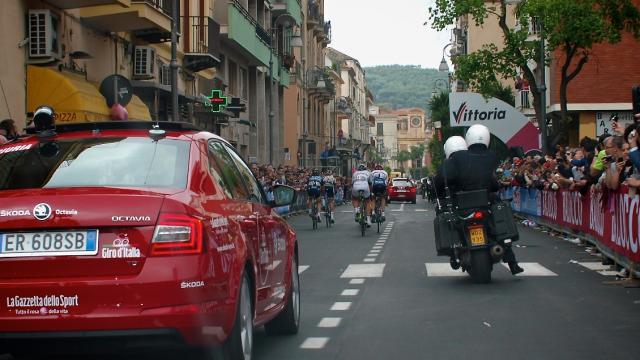
There are big crowds in Sorrento, a mixture of locals and tourists, many of the latter British; some are cycling fans - an RAF flag a nod to Wiggo's Mod tendencies - others holidaymakers excited to find that Mark Cavendish and especially Bradley Wiggins will be passing through.
It's proof that back home, cycling, or at least it's biggest stars - they're the last two athletes to have won BBC Sports Personality, after all - have hit the big time. The previous evening, I'd done a fair bit of unofficial PR work for the Giro among fellow Brits, including telling them where and when to see the race.
With the race heading up and out of Sorrento, the first thing you notice is how the speed of the car is killed as we go uphill. On a bike, it's natural, in a car, going at the speed of the riders ahead of us with no question of overtaking, it feels strange, but you quickly get used to it.
The Giro bills itself as the toughest race in the world in the most beautiful country in the world. Today's stage will turn out to be tougher than expected, and as we head onto the spectacular Amalfi Coast, it's hard to argue with the second part of that description; the scenery is spectacular, the road twisting and turning and giving occasional glimpses of the riders in the break.

“We didn’t see much of the road,” confessed John Steinbeck of his first trip in a car along this very road, that regularly makes lists of the world's most scenic routes, adding, “In the back seat my wife and I lay clutched in each other’s arms, weeping hysterically.”
There's no such worries for us, not least because we don't have to deal with the oncoming traffic that had reduced such a literary giant to a quivering wreck.

The intermittent crackle of race radio keeps us informed of what's going on - riders aare identified by race number, name and team, with the exception of Sky's Salvatore Puccio, who is simply the "maglia rosa" and we and others on the race are warned of approaching towns and villages and specific road hazards; several times, the advice comes over for descents to be tackled in "fila indiana" - single file - an instruction that teams will relay to their riders over their own channels. Instructions are repeated three times; first in Italian, then French, finally in English.
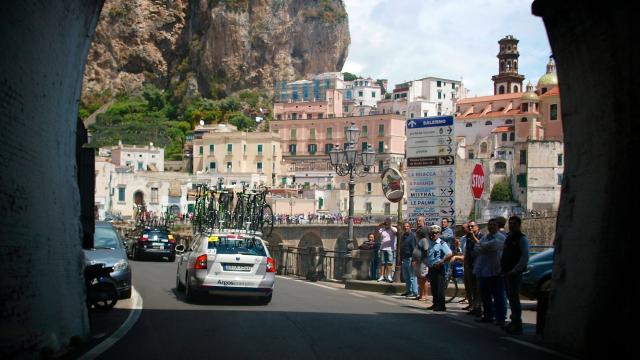
Positano, perched on a clifftop, and Amalfi, clustered round its beach and harbour, flash by, and soon the unmistakeable container port at Salerno looms, with flatter coastline beyond. The low cloud and mist that we'd encountered early on are starting to give way to beautiful blue skies, something that will turn out to be a rarity during this year's race.

The Amalfi Coast was every bit as spectacular as its reputation promised - but it shot by in a flash.

The sign signifies no stopping along the entire route - appropriate for today.

Remember those stickers earlier? Here they are on a rear wheel to make it clear who's using what.
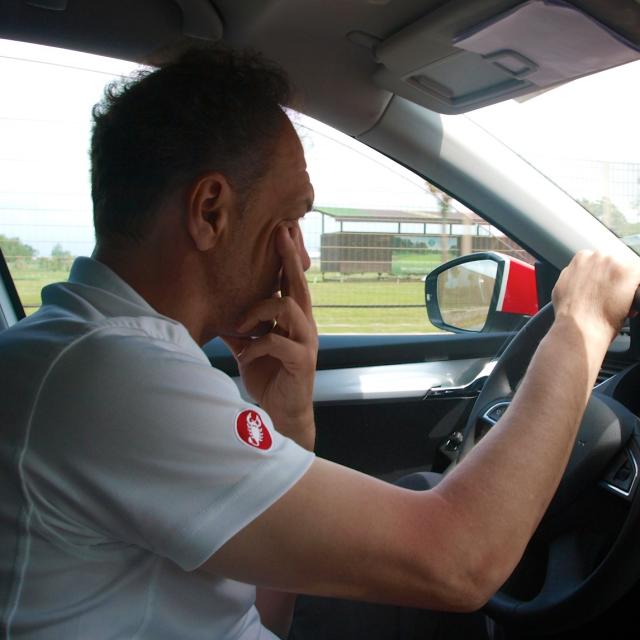
It's a long day behind the wheel, and it won't be over for the Vittoria Servizio Corse team when we hit the finish; they face another drive to their hotel for the night.

After Salerno, the excitement dies down a little. The road is mainly flat and straight - apart from a deviation for the race route to pass the Greco-Roman temples at Paestum apart - but there are a couple of big climbs looming in the latter part of the stage.
Prior to the first of those climbs, there's a bizarre moment when national coach Paolo Bettini, driven by his assistant Gabriele Balducci, pulls up alongside for a quick chat, reinforcing how close-knit the world of professional cycling is, with the paths of many riders and support staff having crossed time and time again.
We're just passing the hilltop town of Castellabate, and Francesco's been telling me about a comedy film shot there, Benvenuti al Sud. He recommends I look it out. Now, he asks Bettini if he's seen it too, and jokes are exchanged before the former world champion drives off. Me, I find the DVD at the bookstore at Rome's Fiumicino airport the next day. It's fun.

The guys who drive ahead of the race knocking out Giro merchandise from their white vans did pretty well when they passed this group...

... although some other spectators seemed a little less enthusiastic.

The arrival of the helicopters tells us the live TV feed has kicked in - unlike team cars, we don't have a monitor on-board. As soon as the break starts the first of those two climbs, the mood changes. We're waved through ahead of the team cars to take up position immediately behind the escapees, the narrow road making it impossible for team cars to overtake should a rider need assistance.
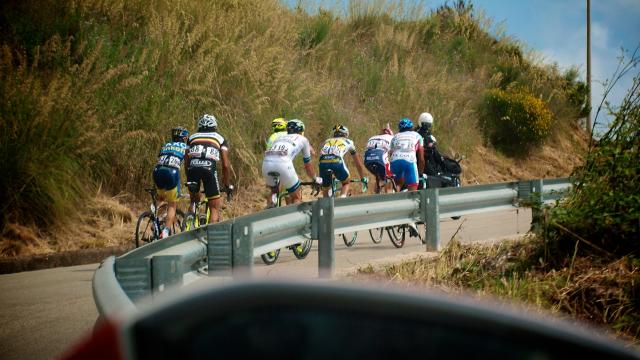
As we head up to the hilltop town of San Mauro Cilento, we can see how hard the riders in the break are working, but Francesco and Albino, with those four decades of experience behind them, are certain they won't stay away. Passing through the town, there's a banner remebering Marco Pantani, not the only one we see today.
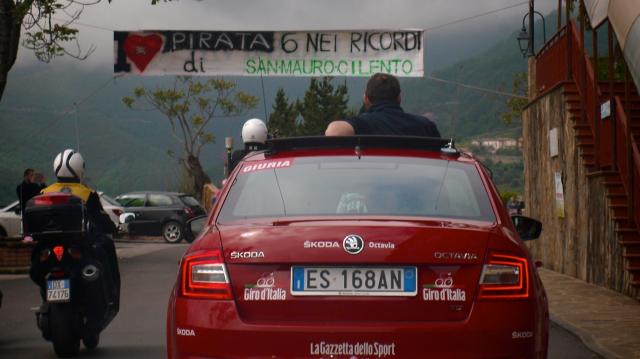
Over the summit, and immediately the foot is on the accelerator as we hit speeds of 90kph on our way back down to the coast. The views are stunning, the journey down smoother than I'd dared hope and absolutely exhilarating. Briefly, I wonder how I would have felt if the stage had stuck to its original route, amended because the roads of the planned descent were considered too dangerous.

Vini Fantini’s Taborre is now on the attack, his companions struggling, and again we're waved ahead to follow him as he begins the second big climb, to Sella di Catona.

The start of a climb is always likely to be on TV, so it's a good place for demonstrators to get their point across; the banner says "We want jobs, not worries" - it's a bit more poetic in Italian.
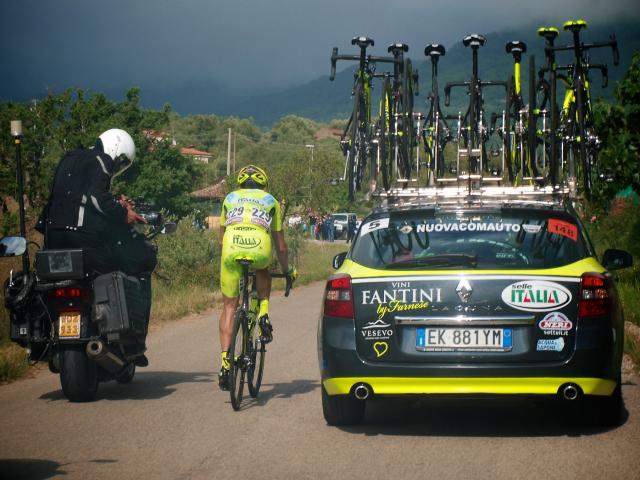
The group is coming up quickly, however, and we now move to the very front of the race, briefly following a police outrider, giving a front-seat view of the different angles and speeds a car and a motorbike take into a corner. I'm relieved for him when he drops back.
Following the top of the climb, it's a fast dash through the old town of Ascea, nestled on top of a hill, to the seaside resort below that takes its name. Through race radio, we know that Hesjedal has attacked, we know the group is bombing down behind us, and there's a new urgency to the driving.
On a corner, I spot some earth that seems to have been dislodged by a small - and very recent - rockfall, and wonder whether that might cause problems; it's not the bend that Michele Scarponi will crash on, but it does highlight the potential hazards.
Suddenly, the road bottoms out and we're heading into Marina di Ascea. Behind us, Luca Paolini has attacked and is heading into the maglia rosa. He's less than a minute behind us, and you can tell from the excitement on the faces of the spectators as they watch us flash by that they know it.
We're under the flamme rouge and into the final kilometre of an unforgettable journey, but there's a final twist - as we head down the finishing straight along the seafront, we're not waved through the deviation to the left, but under the finish line itself, crowds cheering and waving as Paolini rounds the final bend. We catch a glimpse of him on the big screen beyond the finish line, preparing to take the applause.

I've written race reports on upwards of 200 Grand Tour stages, but this is the first time I've seen one from the inside, and it's a huge privilege. It's given me an insight into how the race procession is organised and controlled, of why certain things happen at specific moments.
You have an appreciation of the rhythm of the race that TV pictures can't convey, that sitting in a car for five hours is hard enough work for one day let alone three weeks, and the appearance of the TV helicopters in the latter part of the stage as live coverage kicks in gives rise to the thought that they've missed the splendour of the Amalfi Coast.
It's also reinforced that just as in Wim Wenders' movie Wings of Desire, Guardian Angels spend most of their time patiently observing and waiting, ready to jump into action on those rare occasions the need arises - those they watch over barely registering their presence, but grateful they are there when something goes wrong. Today was one of those occasions that for the riders we were looking after at least, nothing did.
With thanks to all the team at Vittoria Servizio Corse and to Claudia Vianino at Vitamina C.
Latest Comments
- Ohjack 2 sec ago
Had a Ti Brompton stolen on LNER train March '24. Advised guard within 5 minutes (had pulled out of a station, it was there before). Guards did...
- ktache 5 min 12 sec ago
Not that they would be as technical, or maybe quite as grippy, but does the skate industry provide any solutions?
- wtjs 20 min 26 sec ago
the Metropolitan Police contacted Vikash to inform him that they have created a report for the incident and that the video has been “passed to the...
- tom72 29 min 31 sec ago
This highlights how generally awful public bodies are at engaging with the public with regard to everything they do. I work for one by the way -...
- Rendel Harris 47 min 54 sec ago
Sorry to be a killjoy but it doesn't amuse me at all, I hope the idiot gets caught and punished. Putting yourself on the same road as pros...
- willpom @GWRaudax 1 hour 22 min ago
Steve Poulton has just published The Cheltenham Flyer - 10th May https://www.audax.uk/event-details/calendar/13235-cheltenham_new_flyer_200
- David9694 1 hour 39 min ago
Chef left with 'car sticking out of house' on crash-hit road...
- HKR 4 hours 33 min ago
It's not 4k though. It's a 4k sensor. But when image stabilization is on, that's chopped down to little over a 1080 image. ...
- captain_slog 13 hours 47 min ago
Nice idea. Il Lombardia: la classica delle foglie morte. Because that name, Lake Como in autumn, Coppi and proper climbs.
Add new comment
2 comments
Loved that.
Good read.
A more literal translation of the italian also sort of works in english, "We want to be occupied, not pre-occupied!".
Nice article!